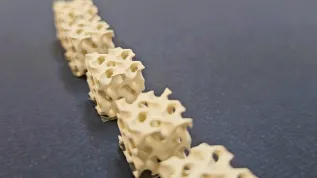
Scientists from three universities in Gdańsk have developed a new crystalline form of chlordiazepoxide, a drug for anxiety and insomnia. According to team leader Professor Marek Wesołowski from the Medical University of Gdańsk, the advantage of the invention is the simple and green method of obtaining the drug.
Research on the innovative solution was conducted by scientists from three universities: the Medical University of Gdańsk (GUMed), the University of Gdańsk and the Gdańsk University of Technology.
The University of Gdańsk Technology Transfer Office reports that the invention was created in connection with the growing problem of mental disorders in societies. Chlordiazepoxide belongs to benzodiazepines, the group of drugs used in the treatment of depression, anxiety disorders, neurosis, insomnia and diseases resulting from the abuse of psychoactive substances. Chlordiazepoxide was discovered in the 1950s by Leon Sternbach, a Polish-American chemist and pharmacist, a graduate of the Jagiellonian University.
Its effectiveness has not been fully exploited so far, because chlordiazepoxide does not dissolve well in water, and as a result, the rate and degree of absorption of the drug in the body are low.
Scientists have created a new salt of chlordiazepoxide with saccharin, which will enable a much better and faster absorption of the drug in the body.
According to Professor Marek Wesołowski from the Department of Analytical Chemistry at the Medical University of Gdańsk, the basic problem in pharmacy is that most active pharmaceutical substances are very poorly soluble or practically insoluble in water, which significantly limits their bioavailability. 'The available literature data show that about 40 percent of active substances are classified as substances practically insoluble in water, while up to 70 percent of active substances being tested as potential drugs are characterized by poor solubility in water', he reports.
He adds that this situation is particularly problematic, because poor water solubility and low dissolution rate of the active substance result in limited bioavailability, i.e. a small amount of the active substance that enters the bloodstream. 'The biological activity of the drug substance in the human body is proportional to the amount of the active ingredient that dissolves in water. Therefore, if the solubility of the drug substance in water is poor, the dose of the drug should be increased to obtain the same therapeutic effect. However, a large dose of the drug may cause increased toxicity of the active substance to the human body, and in addition, it adversely affects the production process of a pharmaceutical preparation with a large dose of the substance, and generates higher costs of the production process', the scientist says.
He adds that currently, the most common method of administering drugs is the oral route. 'In order to induce the therapeutic effect of a drug substance taken orally in a solid form (e.g. a tablet), it is necessary to dissolve it, which is a key factor determining the effect of the drug in the body, because only a dissolved drug substance can be absorbed by the human body', he says.
The scientist emphasises that the desired direction of research - especially from the point of view of the pharmaceutical industry - is to find such an optimal solid form of a given active substance, which would be characterized by greater solubility in water.
Wesołowski says that the invention is addressed to pharmaceutical industry plants. 'The new salt of chlordiazepoxide with saccharin is characterized by better solubility in water compared to pure chlordiazepoxide - an active substance that is very poorly soluble, has anxiolytic and sedative effects. A significant improvement in the solubility of chlordiazepoxide in water may result in higher bioavailability, which makes it possible to reduce the drug dose and limit side effects', he points out.
He adds that another advantage is the simple and green method of obtaining the salt, which does not require advanced equipment or expensive or toxic reagents. 'These advantages of the newly obtained salt can be used by pharmaceutical plants to obtain a new form of the drug containing chlordiazepoxide, e.g. tablets with controlled release of the active substance', he says.
Research related to introducing a new product to the pharmaceutical market is time-consuming and very expensive, it consists of many stages of research, including several phases of clinical trials involving humans, he emphasises. (PAP)
pm/ agt/ amac/













